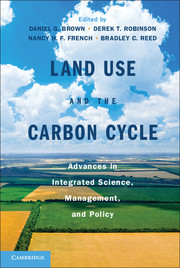Book contents
- Frontmatter
- Contents
- Chapter Authors and Affiliations
- Acknowledgments
- Acronyms
- Part I Introduction
- Part II Measurement and Modeling
- Part III Integrated Science and Research Applications
- Part IV Land Policy, Management, and the Carbon Cycle
- 13 Managing Carbon: Ecological Limits and Constraints
- 14 Effects of Wildland Fire Management on Forest Carbon Stores
- 15 Soil Carbon Dynamics in Agricultural Systems
- 16 U.S. Policies and Greenhouse Gas Mitigation in Agriculture
- 17 Opportunities and Challenges for Offsetting Greenhouse Gas Emissions with Forests
- 18 Opportunities and Challenges for Carbon Management on U.S. Public Lands
- 19 Design and Planning of Residential Landscapes to Manage the Carbon Cycle: Invention and Variation in Land Use and Land Cover
- Part V Synthesis and Future Directions
- Index
- Plate Section
- References
17 - Opportunities and Challenges for Offsetting Greenhouse Gas Emissions with Forests
Published online by Cambridge University Press: 05 February 2013
- Frontmatter
- Contents
- Chapter Authors and Affiliations
- Acknowledgments
- Acronyms
- Part I Introduction
- Part II Measurement and Modeling
- Part III Integrated Science and Research Applications
- Part IV Land Policy, Management, and the Carbon Cycle
- 13 Managing Carbon: Ecological Limits and Constraints
- 14 Effects of Wildland Fire Management on Forest Carbon Stores
- 15 Soil Carbon Dynamics in Agricultural Systems
- 16 U.S. Policies and Greenhouse Gas Mitigation in Agriculture
- 17 Opportunities and Challenges for Offsetting Greenhouse Gas Emissions with Forests
- 18 Opportunities and Challenges for Carbon Management on U.S. Public Lands
- 19 Design and Planning of Residential Landscapes to Manage the Carbon Cycle: Invention and Variation in Land Use and Land Cover
- Part V Synthesis and Future Directions
- Index
- Plate Section
- References
Summary
Introduction
A strong consensus is building on the need to slow the rate of climate change. Emissions must be reduced, and where emission reductions are not financially feasible, mechanisms need to be in place to allow investment in reductions in neighboring areas, neighboring countries, and across the Earth. Forests have a large potential role to play in this system, and the environmental, social, and economic benefits of investing in forests are high. However, challenges exist if we are to maximize the potential of forests to affect climate change.
What Are Offsets?
Greenhouse gas (GHG) emissions regulations typically place a cap on permitted emissions. It is unrealistic to expect industries and companies to immediately and drastically decrease GHG emissions. As a result, a system exists that allows entities that cannot sufficiently reduce their own emissions to invest elsewhere to stimulate emission reductions or increases in sequestration. The financial instrument is typically known as an offset and is measured by Mg carbon dioxide (CO2), or a carbon dioxide equivalent for non-CO2 GHGs (Mg CO2e), which have varying potentials to cause global warming.
- Type
- Chapter
- Information
- Land Use and the Carbon CycleAdvances in Integrated Science, Management, and Policy, pp. 431 - 454Publisher: Cambridge University PressPrint publication year: 2013
References
- 1
- Cited by



